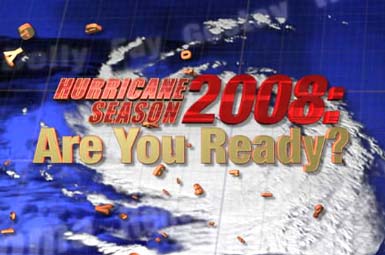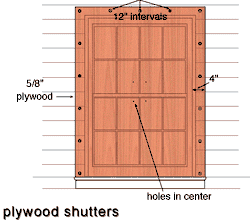|
|
||||||||
|
|
Window Shutters
The easiest designs are those that simply cover the opening with a structural panel such as plywood. In past hurricanes, many homeowners upon returning have noticed their temporary plywood shutters blown off because they were not adequately fastened. If you have a wood-frame house, use adequate fasteners to attach the panels over the openings when a hurricane approaches. Have these temporary shutters stored and ready to use since building supply stores generally sell out of these materials quickly during a hurricane warning. If your home is made with concrete blocks, however, you will have to install anchoring devices well in advance. The American Plywood Association (APA) - The Engineered Wood Association offers a series of Hurricane Shutter Designs. Each design is available for $1, or you can download all five designs from the APA's Web site at no cost. Manufactured ShuttersIf your residence has permanent shutters, evaluate their effectiveness. Manufacturers are responsible for testing their shutters up to the standards necessary to resist wind forces and wind-borne debris. Some shutters are very flexible, especially those that roll up. If struck by a rigid piece of debris, shutters may bend and break the window. To determine whether your shutter can resist this impact, gently lean against it and see if it yields. You can also inspect your shutters to see if they are properly attached to the house and will not fly off during a storm by inspecting the shutter connectors for obvious excessive wear or missing connectors. Ask the shutter manufacturer for proper installation criteria. The above information is taken from IBHS's instructive pamphlet, "Is Your Home Protected from Hurricane Disaster? -A Homeowner's Guide to Retrofit." |
|||||||
|
|
||||||||
Send mail to KeysDAN@keysdan.com with
questions or comments about this web site. |
||||||||

 One of the best ways to protect a home from damage in wind storms is to install impact-resistant shutters over all large windows and glass doors. Not only do they protect doors and windows from wind-borne objects, but they can reduce damage caused by sudden pressure changes when a window or door is broken. Laminated window systems (plastic bonded to glass) are another option, and are a particularly good choice for either building a new home or adding to an old one.
One of the best ways to protect a home from damage in wind storms is to install impact-resistant shutters over all large windows and glass doors. Not only do they protect doors and windows from wind-borne objects, but they can reduce damage caused by sudden pressure changes when a window or door is broken. Laminated window systems (plastic bonded to glass) are another option, and are a particularly good choice for either building a new home or adding to an old one.